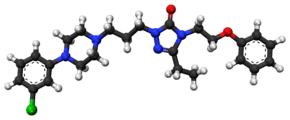Nefazodone
 | |
 | |
| Clinical data | |
|---|---|
| Trade names | Dutonin, Nefadar, Rulivan, Serzone |
| AHFS/Drugs.com | Monograph |
| MedlinePlus | a695005 |
| Pregnancy category |
|
| Routes of administration | Oral |
| ATC code | N06AX06 (WHO) |
| Legal status | |
| Legal status |
|
| Pharmacokinetic data | |
| Bioavailability | 20% (variable) |
| Protein binding | >99% |
| Metabolism | Hepatic (active metabolites, including mCPP)[1] |
| Biological half-life | 2–4 hours |
| Excretion | Urine (55%), Feces (20–30%) |
| Identifiers | |
| |
| CAS Number |
83366-66-9 |
| PubChem (CID) | 4449 |
| IUPHAR/BPS | 7247 |
| DrugBank |
DB01149 |
| ChemSpider |
4294 |
| UNII |
59H4FCV1TF |
| KEGG |
D08257 |
| ChEBI |
CHEBI:7494 |
| ChEMBL |
CHEMBL623 |
| Chemical and physical data | |
| Formula | C25H32ClN5O2 |
| Molar mass | 470.01 g/mol |
| 3D model (Jmol) | Interactive image |
| |
| |
| (verify) | |
Nefazodone (Dutonin, Nefadar, Serzone) is an antidepressant marketed by Bristol-Myers Squibb. Its sale was discontinued in 2003 in some countries due to the rare incidence of hepatotoxicity (liver damage), which could lead to the need for a liver transplant, or even death. The incidence of severe liver damage is approximately 1 in every 250,000 to 300,000 patient-years.[2] On June 14, 2004, Bristol-Myers Squibb discontinued the sale of Serzone in the United States and Canada.[3] Several generic formulations of nefazodone are still available.[4]
Pharmacology
Nefazodone acts primarily as a potent antagonist at the 5-HT2A receptors (Kd 26 nM).[5] It also has moderate affinity for the α1-adrenergic receptor (Kd 48 nM) and 5-HT1A receptor (Kd 80 nM), and very low affinity for the α2-adrenergic receptor (Kd 640 nM) and D2 receptor (Kd 910 nM).[5] Nefazodone has low affinity for the serotonin (200 nM), norepinephrine (360 nM), and dopamine (360 nM) transporters as well, and therefore acts as a weak serotonin-norepinephrine-dopamine reuptake inhibitor (SNDRI).[6] It has negligible affinity for the H1 receptor (24,000 nM) or muscarinic acetylcholine receptors (11,000 nM), and accordingly lacks any antihistamine or anticholinergic side effects.[6]
Dosing
Nefazodone doses for adults typically start at 100 mg twice daily (200 mg/day) to a maximum of 600 mg/day (300 mg twice daily), according to Food and Drug Administration (FDA) regulations. Some patients with severe depression were treated with more than 600 mg/day. Most patients were treated with 300 mg–600 mg daily.
Side effects
Common and mild side effects of nefazodone reported in clinical trials more often than placebo include dry mouth (25%), sedation/somnolence (25%), nausea (22%), dizziness (17%), blurred/abnormal vision (16%), weakness (11%), lightheadedness (10%), confusion (7%), and orthostatic hypotension (5%).[7] Rare and serious adverse reactions may include allergic reaction, fainting, priapism (painful/prolonged erection), and jaundice.[8]
Unlike most serotonin reuptake inhibitors, nefazodone has a low incidence of negative effects on libido or sexual function, and is occasionally used as treatment for SSRI or SNRI-induced impotence and anorgasmia in men.[9] Additionally, unlike mirtazapine, nefazodone is not especially associated with increased appetite and weight gain either.[10]
Interactions
Nefazodone is a potent inhibitor of CYP3A4, an isozyme of the cytochrome P450 system, and may therefore interact adversely with many commonly used medications that are metabolized by CYP3A4.[1][11]
Advantages
Nefazodone's claimed advantages over other antidepressants include reduced possibility of disturbed sleep or sexual dysfunction, and ability to treat some patients who did not respond to other antidepressant drugs.
Nefazodone, though an antidepressant, may also be beneficial in the prophylaxis of migraines due to its antagonistic effects on the 5-HT2A[12] and 5-HT2C receptors.[13][14] It has a more favorable side effect profile than amitriptyline, a tricyclic antidepressant commonly used for migraine prophylaxis.
See also
References
- 1 2 Lexi-Comp (September 2008). "Nefazodone". The Merck Manual Professional. Retrieved on November 29, 2008.
- ↑ Rxlist.com: "Nefazodone Prescribing Information", accessed 8 January 2007.
- ↑ Bootie Cosgrove-Mather for CBS News. December 5, 2007 Anti-Depressant Taken Off Market
- ↑ FDA Orange Book, accessed 15 January 2006.
- 1 2 Cusack B, Nelson A, Richelson E (1994). "Binding of Antidepressants to Human Brain Receptors: Focus on Newer Generation Compounds.". Psychopharmacology (Berl). 114 (4): 559–565. doi:10.1007/BF02244985. PMID 7855217.
- 1 2 Tatsumi M, Groshan K, Blakely RD, Richelson E (1997). "Pharmacological Profile of Antidepressants and Related Compounds at Human Monoamine Transporters.". Eur J Pharmacol. 340 (2–3): 249–258. doi:10.1016/S0014-2999(97)01393-9. PMID 9537821.
- ↑ "Nefazodone (Serzone) FAQ".
- ↑ http://www.drugs.com/serzone.html
- ↑ http://sulcus.berkeley.edu/mcb/165_001/papers/manuscripts/_684.html
- ↑ Sussman N, Ginsberg DL, Bikoff J (April 2001). "Effects of nefazodone on body weight: a pooled analysis of selective serotonin reuptake inhibitor- and imipramine-controlled trials". The Journal of Clinical Psychiatry. 62 (4): 256–60. doi:10.4088/JCP.v62n0407. PMID 11379839.
- ↑ Spina E, Santoro V, D'Arrigo C (July 2008). "Clinically relevant pharmacokinetic drug interactions with second-generation antidepressants: an update". Clin Ther. 30 (7): 1206–27. doi:10.1016/S0149-2918(08)80047-1. PMID 18691982.
- ↑ Saper JR, Lake AE, Tepper SJ (May 2001). "Nefazodone for chronic daily headache prophylaxis: an open-label study". Headache. 41 (5): 465–74. doi:10.1046/j.1526-4610.2001.01084.x. PMID 11380644.
- ↑ Mylecharane EJ (1991). "5-HT2 receptor antagonists and migraine therapy". J. Neurol. 238 (Suppl 1): S45–52. doi:10.1007/BF01642906. PMID 2045831.
- ↑ Millan MJ (2005). "Serotonin 5-HT2C receptors as a target for the treatment of depressive and anxious states: focus on novel therapeutic strategies". Therapie. 60 (5): 441–60. doi:10.2515/therapie:2005065. PMID 16433010.